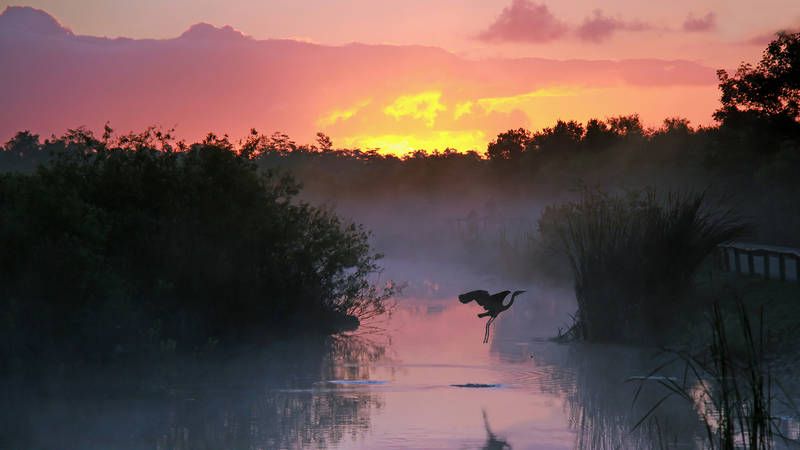Restoring America’s Everglades to solve Florida’s water crisis
Florida’s waters are under siege. Seagrasses are dying. Algae is blooming. Fish populations are plummeting, and with them, the state’s commercial and recreational fishing industries. Downstream lies Everglades National Park, one of the most unique, biodiverse and endangered ecosystems on the planet.
It can be difficult to believe that a park with such distinctive natural beauty could also have such severe environmental problems. Though visitors to the region are wowed by its spectacular wetlands, the truth is that development has changed where water flows within the Florida Peninsula — and where it doesn’t. As a result, for all its splendor, the Everglades ecosystem severely lacks the freshwater it needs.
On Earth Day, Everglades National Park Gets Critical Freshwater with Additional Bridging of Tamiami Trail
Major milestone for restoring America’s Everglades with the kickoff of an additional 2.6 miles of bridging on Tamiami Trail.
See more ›NPCA’s advocates have been taking action for years to help this crisis, and last month, we made major progress on the problem. But to understand how we are improving Florida’s waters, it helps to get a snapshot of how things got so bad.
It’s hard to fully comprehend the enormity of the natural Everglades. Historically, this ecosystem contained the land that makes up modern-day Disney World as well as everything as far south as Key West — not just the land and water within the national park boundaries. The greater Everglades landscape is a patchwork of wetlands, sawgrass marshes, prairies, ponds, sloughs and upland forests that spans hundreds of miles north to south and reaches from the Gulf of Mexico to the Atlantic Ocean.
At the heart of this system is Lake Okeechobee, the second-largest freshwater lake in the continental United States. Historically, lake water would gently spill over its southern boundary and cascade south toward Florida Bay and the Keys. This shallow, slow-moving sheet of freshwater covered almost 11,000 square miles, and its journey south would purify the water as it passed through plant life that absorbed its nutrients. This abundant, clean freshwater resulted in one of the most biodiverse and unique ecosystems on the planet, teeming with life and creating an unparalleled ecological paradise. There is simply no other Everglades in the world.
What Mother Nature perfected over centuries, human interference devastated in decades. Turn-of-the-century revolutionaries saw Florida as a place of unlimited opportunity — a vast wilderness to be tamed so that residents and tourists could visit and live in paradise. In 1903, the federal government ceded 20 million acres of public land to Florida on the condition that the state drain the lands and make them developable, hoping to provide a “new frontier” for Americans and a boom in the national economy.

Everglades National Park
One of the largest wetlands in the world, this iconic “River of Grass” protects 1.5 million acres of subtropical wilderness in South Florida.
See more ›In the years that followed, the Everglades was drained and dissected for development ventures. Water that once flowed freely from Lake Okeechobee to the Keys was shunted through canals and levees to the coasts, then discarded to the tide. Meanwhile, development stretched across the state, enabled by new railroads and the mass-production of modern-day air conditioning.
Florida’s cities exploded with homes and hotels, farms and freeways, boosting the economy. In just a few short years, the environment of the state was forever changed. One of the most harmful projects was a major roadway that connected two of Florida’s biggest cities, Tampa and Miami — Tamiami Trail. After years of construction, the roadway opened in 1928. The two-lane asphalt “trail” runs straight through the heart of the River of Grass, blocking the flow of water entering Florida Bay and leaving the sensitive ecosystem starved for freshwater.
Meanwhile, water from Lake Okeechobee that could no longer flow south had to go somewhere. It was shunted east and west, to the St. Lucie and Caloosahatchee estuaries respectively. Booming agricultural and urban development heavily polluted these waters. To this day, these filthy estuaries contaminate local waterways and wreak havoc on the fishing and tourism industries.
By 1932, America’s Everglades was in peril. Its natural footprint was cut in half. The region lost 70 percent of its water flow. Development fragmented wildlife habitat, and native species suffered.
Everglades National Park was established in 1934 to protect what remained of the vanishing natural Everglades. It was the first national park that was dedicated not for its scenic views but for its incredible biodiversity. However, scientists came to recognize that reversing the damage to this ecosystem was critical to maintaining its environmental and economic viability. Indeed in the past few decades, numerous proposed restoration projects have addressed ways to reverse these mistakes and restore the Everglades.
NPCA has long been advocating for ways to send more water south and help bring life back to Everglades National Park. By diverting flows from Lake Okeechobee back to their historic pattern through the heart of the ecosystem, we can restore America’s Everglades and save Florida’s estuary communities from the ecological turmoil that has reigned for decades.
One project holds the key to this restoration — bridging Tamiami Trail. Bridging the trail literally means elevating strategic portions of the roadway above the wetlands, reconnecting wildlife habitat and allowing water that has been blocked for decades to flow freely into Florida Bay. One mile of the 6.5-mile Tamiami Trail bridging is already complete, with more progress on the horizon.
On Earth Day 2016, NPCA joined the Department of the Interior, the National Park Service and others to celebrate the kickoff of the next 2.6 miles of bridging — an incredibly fitting project to help celebrate the National Park Service centennial and its legacy of stewardship.
Bridging Tamiami Trail is one important piece of a much larger restoration puzzle. A series of interconnected efforts to store and treat Florida’s water and restore its historic flow south must be planned and constructed concurrently to bring back the full splendor of the natural Everglades. The U.S. Senate recently introduced the Water Resources Development Act of 2016, which will authorize other critical efforts to supply clean water through the heart of the ecosystem that can flow underneath the newly bridged Tamiami Trail. Together, a suite of ongoing restoration projects will bring clean water back to Everglades National Park – and with it ecological conditions that will allow the abundant native species of the Everglades to thrive once more.
Sending water south is the only way we can hope to restore Everglades National Park and solve Florida’s water crisis. As we celebrate the National Park Service’s centennial year, we must continue to make progress reversing the years of damage to this exceptional place so that generations of visitors can be inspired by the majesty of America’s Everglades for years to come.
About the author
-
 Cara Capp Greater Everglades Associate Director, Sun Coast
Cara Capp Greater Everglades Associate Director, Sun CoastCara works to restore and protect natural resources in and around Florida's national parks as the Sun Coast's Greater Everglades Associate Director.
-
General
-
- Park:
- Everglades National Park
-
- NPCA Region:
- Sun Coast
-
-
Issues


